Approach to education in English
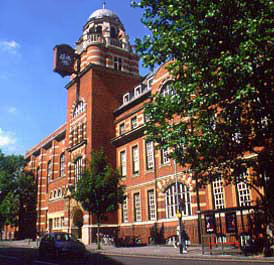 Catching up on a new wave of articles on education, I would like to share my experience in master's studies at City University London (CUL). During the winter session, I already wrote about how exams are held here , and now I am going to review some of the features of the university where I study. Many of the things that will be discussed are worthy of being borrowed. The greatest attention will be paid to those moments that, one way or another, are close to the subject of Habr.
Catching up on a new wave of articles on education, I would like to share my experience in master's studies at City University London (CUL). During the winter session, I already wrote about how exams are held here , and now I am going to review some of the features of the university where I study. Many of the things that will be discussed are worthy of being borrowed. The greatest attention will be paid to those moments that, one way or another, are close to the subject of Habr.The article is quite extensive, and there are a lot of photos in it, so I warn you: traffic .
Instead of compiling a coherent story, I decided to go separately on the main points. In the absence of time, you can read only some parts of the article, or put
')
Personal identification
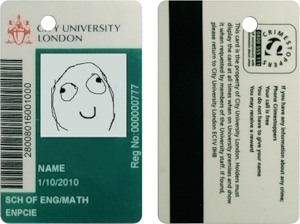 Immediately, on the very first day of the appearance in the university as a student, a person is given everything necessary to start a full life in a university environment. Instead of a pack of "student - record books - reader's pass - trade union card", the student receives a single universal student plastic card the size of an ordinary bank card. What it represents is shown in the figure on the right. The card is “printed out” immediately after the photo was taken, right in the student center. There is no need to stand in queues several times while waiting to receive your documents. With this card, a student can be identified for absolutely any purpose: on the exam during the session, as well as when entering the building, in the library. All employees of the university from the rector to the watchman have exactly the same card, the external difference is only in the signature and background color. In case of loss, the document is restored in five minutes (checked). Simple, convenient, versatile.
Immediately, on the very first day of the appearance in the university as a student, a person is given everything necessary to start a full life in a university environment. Instead of a pack of "student - record books - reader's pass - trade union card", the student receives a single universal student plastic card the size of an ordinary bank card. What it represents is shown in the figure on the right. The card is “printed out” immediately after the photo was taken, right in the student center. There is no need to stand in queues several times while waiting to receive your documents. With this card, a student can be identified for absolutely any purpose: on the exam during the session, as well as when entering the building, in the library. All employees of the university from the rector to the watchman have exactly the same card, the external difference is only in the signature and background color. In case of loss, the document is restored in five minutes (checked). Simple, convenient, versatile.A student card is far from the only thing that a person receives upon admission. An account is created for him to access the computer network, mail is set up in the
Computerization
 All user machines of the university, of which there are more than one hundred, are combined into one network. Each student has a personal login and password that work on any computer at the university. Basically, all machines have Windows XP SP3 installed, but there are audiences where OpenSUSE stands. Booting is done from a network drive. Windows has a huge number of pre-installed programs for all occasions: from Firefox and Google Earth to Adobe CS3 Design Premium, Microsoft Visual Studio 2008, Matlab, NetBeans, and so on. Naturally, all software is legal and not trial.
All user machines of the university, of which there are more than one hundred, are combined into one network. Each student has a personal login and password that work on any computer at the university. Basically, all machines have Windows XP SP3 installed, but there are audiences where OpenSUSE stands. Booting is done from a network drive. Windows has a huge number of pre-installed programs for all occasions: from Firefox and Google Earth to Adobe CS3 Design Premium, Microsoft Visual Studio 2008, Matlab, NetBeans, and so on. Naturally, all software is legal and not trial.The system is designed so that all changes and settings that the user has made on one computer will be visible on the other after logging in. I did not notice any strong restrictions on rights: without problems, additional software was substituted and the Russian keyboard layout was set up.
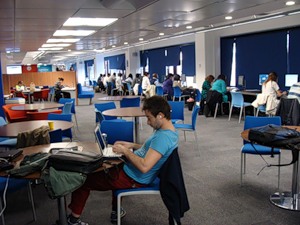 One of the “attractions” of the university is a computer room, where you can come to work at any time. Along the perimeter of the room are dozens of cars with full Internet access and a full set of necessary programs. All you need is to enter your data to enter. There are special stations for teamwork. In addition to a giant monitor and a table with built-in USB ports and a control panel, such systems have a video camera built into the ceiling. You can put a document on the table and increase it to the desired size so that everyone can see the necessary details on the screen. The computer room is open until 12 on weekdays and until 9 pm on weekends. In the session, it does not close at all.
One of the “attractions” of the university is a computer room, where you can come to work at any time. Along the perimeter of the room are dozens of cars with full Internet access and a full set of necessary programs. All you need is to enter your data to enter. There are special stations for teamwork. In addition to a giant monitor and a table with built-in USB ports and a control panel, such systems have a video camera built into the ceiling. You can put a document on the table and increase it to the desired size so that everyone can see the necessary details on the screen. The computer room is open until 12 on weekdays and until 9 pm on weekends. In the session, it does not close at all.




Each account is assigned an account, the money on which you can spend to print documents. Printers have both color and black and white and are also available on the network. Printing one black and white page costs only
University WiFi is also there. It is available only to students and employees of the university, not weakly protected and free of charge. Authorization in a wireless network is carried out using your username and password.
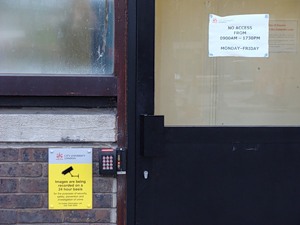 The university has a special room, which is open 24 hours . There are also dozens of computers working for students around the clock. It is possible to enter it at night only across the street. You need to hold your student next to the door and
The university has a special room, which is open 24 hours . There are also dozens of computers working for students around the clock. It is possible to enter it at night only across the street. You need to hold your student next to the door and Nobody forbids "sitting on Facebook" and doing other stuff at computers, and idlers are not expelled. Nevertheless, most of the students are engaged in business, because everyone understands that in order to make money in the UK, you need to be a professional, and for this you need to go to university not only to warm a chair.
University website
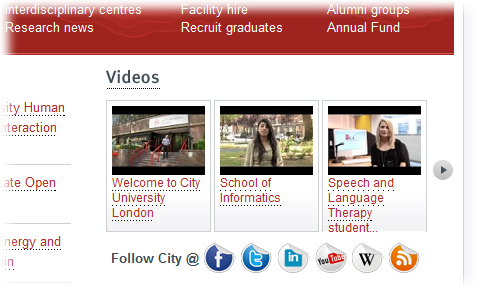 University sites with content sucked from the finger are unfortunately not uncommon. The usefulness of such sites tends to zero, and the funds spent on them absolutely do not justify themselves. In CUL, the picture is reversed. The official
University sites with content sucked from the finger are unfortunately not uncommon. The usefulness of such sites tends to zero, and the funds spent on them absolutely do not justify themselves. In CUL, the picture is reversed. The official One of the main and most important sections of the site is hidden to the public. This is an automatic learning management system, here called cityspace . It works on the basis of the Blackboard Learning System (a turnkey solution for such tasks). Through this system, students get access to educational materials, see a list of assignments in the subjects taught, can watch their grades for laboratory and course students. It is even possible to chat with other students and teacher. It turns out that in special cases it is theoretically possible to study a whole semester at all without visiting a university if it is physically impossible to do so.
Through the site for students open access to the electronic library (this will be discussed later), it is possible to book places for upcoming student activities and do many other things that are reflected in real life.
Also on the site there is a system of redirects for the convenience of typing addresses in the browser. For example, to get to the cityspace
In short, the site is not in a vacuum and is designed to be used as a tool, and not just for it.
[first name].[last name].[sequence number]@city.ac.ukStudent email is a great tool for communication within the university. The schedule of classes or exams became known - a letter with an attached document or link comes immediately; if someone had to postpone the lecture, everyone was instantly informed; the university gathered to hold some important and interesting event - again a letter. The dean's office is engaged in public distribution, and this is the responsibility of its employees. The system already has automatically generated lists of users that are accessible from the address book, so it’s convenient to make notifications before the madness. If a student has any question to the teacher, you can easily find his email address on the site and contact without fear of misunderstanding or ignoring.
Mail service is implemented using Microsoft Exchange Server . The web interface on the university site is quite suitable for use, but it is possible to redirect letters to your regular mailbox, which is what many people use.
By the way, each mailbox still has an alias, where the username matches the student ID and login to access any of the computers of the university, something like abcd123@city.ac.uk. This alias can be useful, for example, to a teacher who decided to send
Intra-university e-mail is a necessary and important tool in our time for work, which helps to solve many problems and save hundreds of hours of valuable time for both students and employees of the university.
Library
 It would seem, what can be special about the university library? It turns out that everything can be special. The organization of the method of circulation of books in CUL, to put it mildly, refreshed my brain, since before that I had only been in “traditional” libraries with lockers-catalogs and always tired employees looking for and issuing books on request. Immediately everything is arranged at times more efficiently.
It would seem, what can be special about the university library? It turns out that everything can be special. The organization of the method of circulation of books in CUL, to put it mildly, refreshed my brain, since before that I had only been in “traditional” libraries with lockers-catalogs and always tired employees looking for and issuing books on request. Immediately everything is arranged at times more efficiently.The library in cul is awesome. It is located on several floors and to the eyeballs is furnished with shelves of books. With the traditional approach, servicing such a quantity of literature would require more than a dozen employees just to work on extradition. All this staff is replaced by several looking after the order and two people sitting at the exit. Human resources are saved by the original approach.
 The entrance to the library is fenced with turnstiles, and to get to the part of the building where it is located, you need to hold your student. Immediately behind the turnstile are the frames (as in stores), which do not make it possible to carry away a book or magazine without registering them for themselves. Books have radio frequency labels reusable. To deactivate them, you need to go to one of the racks, located on several pieces on the floor, give the computer to read the bar code from the student, then enter your PIN code and put the book barcode up on a special surface. There will be degaussing strips and attaching a book to a student account. Everything, it is possible to put the book in a backpack and easy to leave.
The entrance to the library is fenced with turnstiles, and to get to the part of the building where it is located, you need to hold your student. Immediately behind the turnstile are the frames (as in stores), which do not make it possible to carry away a book or magazine without registering them for themselves. Books have radio frequency labels reusable. To deactivate them, you need to go to one of the racks, located on several pieces on the floor, give the computer to read the bar code from the student, then enter your PIN code and put the book barcode up on a special surface. There will be degaussing strips and attaching a book to a student account. Everything, it is possible to put the book in a backpack and easy to leave.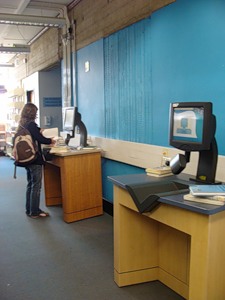 It turns out that any student has full physical access to all materials and can select and browse through books before taking something home. Although making a book is not necessary at all - there is a reading room, even a few. Some floors have lockable rooms where you can study in a group without disturbing the others. The library is open until midnight, on weekends - until 9 pm, and in the session - around the clock.
It turns out that any student has full physical access to all materials and can select and browse through books before taking something home. Although making a book is not necessary at all - there is a reading room, even a few. Some floors have lockable rooms where you can study in a group without disturbing the others. The library is open until midnight, on weekends - until 9 pm, and in the session - around the clock.For literature search there is a university portal library.city.ac.uk , where you can find any library book and find out exactly where it is, how many copies are available and for how many days you can take it. The library additionally has several workstations that have access to the directory, but are disconnected from the Internet. Their presence makes it easier to find a suddenly needed book. The search system is quite intelligent and allows you to filter the issue according to criteria such as year, publishing, authorship, subject, etc. You can add a book to your bookmarks, make a list of favorite books, go directly to the Amazon site, if you want to buy it, and much more .
I wonder how many hundreds of such search engine catalogs were made free of charge by students of Russian universities in the framework of graduation projects and buried immediately after the “ex.” Exhibit?
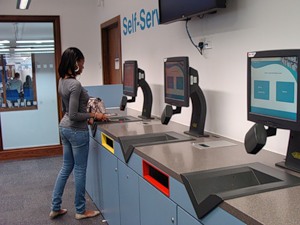 Sometimes a book is given for a limited time, for example, a week (it all depends on its popularity and the number of pieces purchased). If by the end of the term there is a desire to stretch the reading process, then the book can be extended without leaving the house on the library portal. For students who have forgotten about the fact that they have to return something, the system will send an e-mail alert and charge a penalty to special read comrades. Return of literature also occurs without the participation of staff, in self-service mode. It is enough to scan the barcode of the book and throw it into a special urn. At the end of the working day, all returned books will be checked, sorted, rolled back on the carts to their native shelves and returned back to the shelves.
Sometimes a book is given for a limited time, for example, a week (it all depends on its popularity and the number of pieces purchased). If by the end of the term there is a desire to stretch the reading process, then the book can be extended without leaving the house on the library portal. For students who have forgotten about the fact that they have to return something, the system will send an e-mail alert and charge a penalty to special read comrades. Return of literature also occurs without the participation of staff, in self-service mode. It is enough to scan the barcode of the book and throw it into a special urn. At the end of the working day, all returned books will be checked, sorted, rolled back on the carts to their native shelves and returned back to the shelves.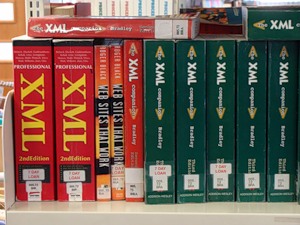 This system is not a university development, but a turnkey solution from 3M, a library equipment company .
This system is not a university development, but a turnkey solution from 3M, a library equipment company .In addition to the "material" books and magazines, students can use several private paid databases containing a large number of electronic books, journals, scientific publications. All of them are available through the university site after authorization. Virtually all of this material can not be found on the Internet, because it is provided only by subscription. The university pays for such “pleasure” a lot of money, but this is part of the training, it should be, and rightly so.
Lecturing
 It is absolutely unnecessary to go to lectures, and even more so to write something to them. They are held to submit knowledge and clarification of the material, and not to gather and arrange a rite of collective rewriting of the read aloud summary. There are no checks for notebooks and no tolerances for the exam on the result of visits. Why? Because the goal of education is not in this, but in obtaining skills and information and checking the final result. Knowledge is measured during the exam and after the completion of semester work, and not by the number of minutes that the student watched the teacher in his mouth and rewrote absolutely incomprehensible terms.
It is absolutely unnecessary to go to lectures, and even more so to write something to them. They are held to submit knowledge and clarification of the material, and not to gather and arrange a rite of collective rewriting of the read aloud summary. There are no checks for notebooks and no tolerances for the exam on the result of visits. Why? Because the goal of education is not in this, but in obtaining skills and information and checking the final result. Knowledge is measured during the exam and after the completion of semester work, and not by the number of minutes that the student watched the teacher in his mouth and rewrote absolutely incomprehensible terms.Usually all the lecture material is in electronic form. It is available to all students on the website of the university from the very beginning of the semester (each student has access to only the material of those subjects that he has conducted, which is logical). The most common formats are Microsoft Power Point presentations and PDF documents. Before you gather for a lecture, you can figure out what it will be about, and decide not to go, or, conversely, prepare some questions on the topic. Often, students print out the presentation material in advance and make notes on their leaflets while the teacher talks about everything in detail. Before exams, these printouts are the best assistant to prepare. In short, there is no insanity and creation of an artificial restriction of access to the material, which allows students to use time as much as possible for themselves effectively.
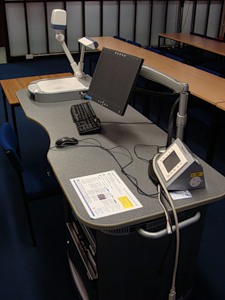 In each lecture hall, special equipment is installed, the same throughout the university. The kit includes a table, a computer with a monitor on a movable stand, a projector and an electronic overhead projector (an overhead projector with a camera and connected to a computer). Authorization on such computers is the same as on any other machines of the university - with a single login and password. It is very convenient. For example, before answering a seminar, you can distribute the necessary files to your desktop on another computer, and, having logged in, start the performance without any hitches with flash drives and other nonsense.
In each lecture hall, special equipment is installed, the same throughout the university. The kit includes a table, a computer with a monitor on a movable stand, a projector and an electronic overhead projector (an overhead projector with a camera and connected to a computer). Authorization on such computers is the same as on any other machines of the university - with a single login and password. It is very convenient. For example, before answering a seminar, you can distribute the necessary files to your desktop on another computer, and, having logged in, start the performance without any hitches with flash drives and other nonsense.By the way, I like the way the relationship between teachers and students is built here - I saw much more mutual understanding. There is no feeling that different generations of people live in different worlds. As it seems to me, the British with age are not at all very susceptible to “canning,” and there is no sense of a gap between people of different ages. For example, you can see students, businessmen and retirees in local bars at neighboring tables, and this is normal. It would be desirable for us to make this happen too.
"Little things"
The world consists of details and trifles. Who does not know how to take them into account during work, will not be able to get advantages over others. Little things allow us to evaluate the quality of a system, and at the same time they can make life more pleasant, and sometimes even save it. In this last (fortunately for the reader) section of the article, there will be a brief overview of those things without which, as some might think, “everything would work”. At the same time, these things do not cease to be important, and their presence once again speaks about the intelligence of those responsible for the university.Navigation system and design
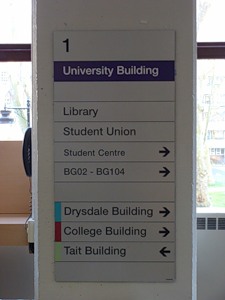 In CUL you can find a good example of what should be the navigation through the institution, what can be informational posters and announcements, and indeed the appearance of the university. For all the time I have not met a single official sign, look at that would be unpleasant.
In CUL you can find a good example of what should be the navigation through the institution, what can be informational posters and announcements, and indeed the appearance of the university. For all the time I have not met a single official sign, look at that would be unpleasant.About the navigation system in a nutshell: each building has its own color on all plans and schemes, which makes it easier to navigate. Plates with signs are hung everywhere. The form of the plates allows, if necessary, to add or remove one or another item without special expenses, and the font and appearance are chosen so that people on these plates are oriented, rather than reflect on the design, looking at them. I was not able to find a plan on the Internet, of which I speak, in normal quality (the schemes on the site are more general), so I can only see it in my crooked photo.
It will not be possible to tell everything in detail. Just look if you wish:












A funny fact: on the doors of the offices of some teachers there are peculiar signs in the shape of a clock with an arrow indicating whether a person is free now and whether he is there. Original and practical.
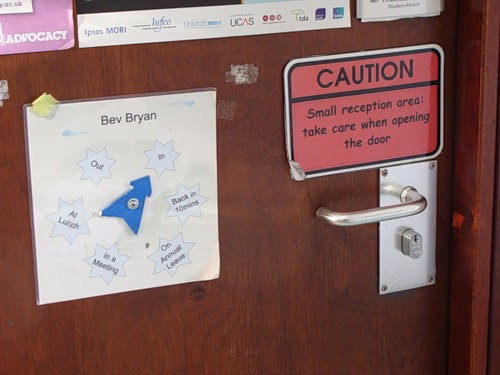
Availability, reasonableness of possible emergencies
 There is not a single room at the university that would be difficult for a person with disabilities to reach and there is not a single door with a threshold. This is not even a feature of the university, but a state standard that has been adopted for a long time and is strictly observed not only on paper. There are voice alerts in elevators, Braille on signs in some places, an opportunity for people with limited vision to change the style of a university website, and so on. All this is one of the indicators of the culture of society and the country.
There is not a single room at the university that would be difficult for a person with disabilities to reach and there is not a single door with a threshold. This is not even a feature of the university, but a state standard that has been adopted for a long time and is strictly observed not only on paper. There are voice alerts in elevators, Braille on signs in some places, an opportunity for people with limited vision to change the style of a university website, and so on. All this is one of the indicators of the culture of society and the country. I wonder how many people ever thought about how to evacuate a wheelchair in the event of a fire in the building? The problem is that elevators cannot be used, and not everyone can carry an adult person on them. Just for such situations (which, according to British scientists, do not occur more than once every 9000 years), special folding chairs are attached to the wall next to each staircase at the university next to each staircase (evacuation / escape chairs). Each such chair has an emergency telephone so that you can ask for help if there is anyone around. Since the article on Wikipedia about these chairs is not serious, let me give a link to a promotional video .
I wonder how many people ever thought about how to evacuate a wheelchair in the event of a fire in the building? The problem is that elevators cannot be used, and not everyone can carry an adult person on them. Just for such situations (which, according to British scientists, do not occur more than once every 9000 years), special folding chairs are attached to the wall next to each staircase at the university next to each staircase (evacuation / escape chairs). Each such chair has an emergency telephone so that you can ask for help if there is anyone around. Since the article on Wikipedia about these chairs is not serious, let me give a link to a promotional video .Elements of emergency navigation correspond not only to the requirements of firefighters, but also to common sense - the “Powder go away” sign cannot be found here. The doors of emergency exits are not locked (in case of terrorism), and along the perimeter of the buildings there are points of people’s gathering after the evacuation (emergency assembly points). That is where the real concern for the life and health of people.



Unofficial life
On the ground floor of one of the buildings of the university there is a bar: a regular bar, where they sell regular beer, and where you can just sit. Its only difference from other similar places is the need to show the student at the entrance. The bar occasionally hosts some informal events and parties. Once a week, a university club of poker players gathers here, and people play with each other for a small but real money. Such a “lawlessness” by the standards of an average adult Russian, oddly enough, passes without any incidents: no one breaks the glass in a radius of a kilometer, does not arrange fights and fights. Performance is also not reduced. At the same time, the university gets “additional advantages in karma”, and students have a good, cultural and safe time. In the end, absolutely everyone is satisfied.
The university also has many areas for recreation and leisure.



Conclusion
Why did I tell about all this? I hope that among those who have read this article there are people who work, or will work in the field of Russian education and would like to change something in their department, faculty, or university. To start improving things around you, financial investments are not always needed: sometimes there is enough idea, desire and lack of pessimism. If my article serves as an occasion to change something in the work of at least one teacher, it means that I have not wasted time.In order for the diplomas of the majority of Russian universities to be appreciated all over the world as well as British ones, you need to work hard and hard. If you do not change anything, after graduation, Russian students will run for several days and sign detour sheets,
The source of the photo at the beginning of the article is http://www.city.ac.uk/aboutcity/ .
Rozhitsa on the student - http://www.epicrage.org/2009/01/its-not-a-down/ .
On which hosting images are, you already know.
Source: https://habr.com/ru/post/90509/
All Articles